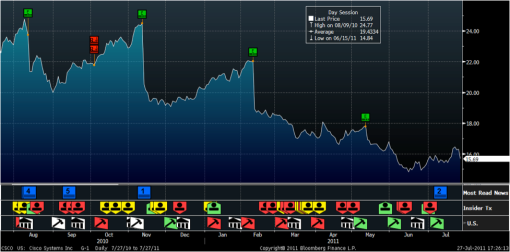The Earnings Season
Every couple of months a really exciting time comes around for traders and investors alike, a time to see if these companies, that have consumed hours of people lives in the form of research and reading, report how well or poorly they did last quarter. The earnings seasons fill the markets with volatility and just pure craziness, however there is some major money to be made here, so its worth taking a couple of minutes to see just what is going on and how can we benefit from it.
Leading Indicators: Companies report individually at various times throughout the year because of differing fiscal year dates. This means that a sector does NOT report all at once. Sometimes you can look at company A, who reported earnings today, and forecast how a similar company will do. For example, today Juniper (JNPR) reported earnings that were less than satisfactory, causing a 21% dive in their price. Cisco (CSCO) who doesn’t even report their earnings until August had a 4% dip for not other reason than it being a rival company to Juniper. It makes sense, if company A had weak sales, chances are a company will have similar results. (Excluding outliers like Apple who consistently has super human mega growth.)
Analyst Estimates: Professionals are tracking companies constantly throughout the whole year. Some analysts commit all their time to following a single sector, just so that they can better forecast what will happen in the future. Although they are very smart and make great estimates, they are usually wrong. Partially because they are making estimates on public information that the company releases, but some of the biggest stock price moving information is held private until earnings are released. When the analysts are wrong, is when it is time to make some money. If the economy is doing bad, and the analysts predict that company A’s EPS (Earnings per share) will decrease from 7 to 6, and they report EPS of 6.5 then you have a POSITIVE surprise. Even though it is worse than last year, it is higher than the analysts forecasted, usually causing an upward movement in price. This is because the somewhat efficient markets will adjust the prices of stocks to the analysts estimates, until actual numbers are released.
The Whisper Number: Whereas analyst’s estimates are a helpful guide, you can go one step further to the whisper number. The whisper number gives us a point at which the surprise will be efficient enough to significantly move the stock price. WhisperNumber.com defines it as “the collective expectation of individual investors for quarterly earnings”. So if the analysts are saying that company A’s EPS will be 5.6 and the whisper number is 6.1, then chances are that the stock price will not have much of an effect if EPS is between the 5.6 and 6.1 range, even though it beat estimates.
EPS vs Sales: The graph below is of Cisco’s price over the last year (graph generated on Bloomberg). The blue squares with an “E” in them represents when earnings were released. If the “E” is green it means that the actual earnings were better than analysts were predicting, if it is red then it means the actual was less then. We see that in the last year ALL FOUR quarterly earnings were better than expected, but the stock took a huge dive every time. Why would that happen? It is all about the relationship between the EPS and Sales.
Earnings per share takes into account all of your expenses that are apart of your business (bottom line). Sales is just a sharp measure of how much money came in before any expenses (top line). In all four of these circumstances Cisco’s EPS surprise was significantly greater than their sales surprise. At first it looks good, all positive numbers, but as we analyse it we see that there are a couple of red flags. The only way for earnings to grow is if you grow you top line, your sales, OR you cut your expenses. The last four quarters Cisco has had very puny growth in sales but has managed to make their margins bigger and bigger. This may look good on paper, but in reality investors know that the company is not growing, and if so many consistent cuts are being made, it may begin to shrink in the near future.
 We learn from Cisco that it is not always about simply beating the estimates, but the smart investor will look at the numbers and see what they could mean. Cisco’s stock price has dropped dramatically every time they have reported earnings in the last year, is this a trend? They report again on August 10th 2011, with Juniper having a horrible earings report, Cisco is not in a great position. If they have a huge positive surprise it will be a great time to buy because the market is already adjusting for bad earnings. But when we look at the historical data above, unless sales have really bumped up, it may be a great shorting opportunity.
We learn from Cisco that it is not always about simply beating the estimates, but the smart investor will look at the numbers and see what they could mean. Cisco’s stock price has dropped dramatically every time they have reported earnings in the last year, is this a trend? They report again on August 10th 2011, with Juniper having a horrible earings report, Cisco is not in a great position. If they have a huge positive surprise it will be a great time to buy because the market is already adjusting for bad earnings. But when we look at the historical data above, unless sales have really bumped up, it may be a great shorting opportunity.
~Wall Street Surfer~








